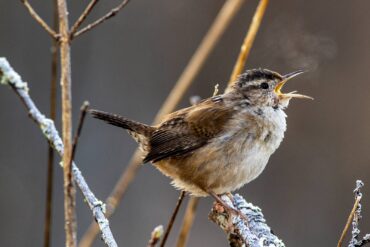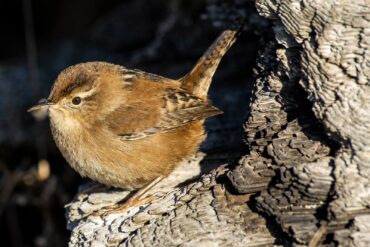
Some people like to talk. Gregarious folks never run out of things to say, nor do they seem to tire of speaking. Others are quieter and only talk when it’s necessary.
It is the same in the world of birds.
Some birds call almost incessantly, including gulls, crows and grackles. Others rarely utter a peep. When it comes to songbirds, some are subtle, while others, particularly wrens, frequently announce their presence.
Most wrens are small, highly chatty songbirds whose overpowering voices do not match their diminutive size. North America is home to 11 species of wrens, 10 of which are found in the United States. Washington hosts six species of wrens. Canyon and rock wrens are limited to Eastern Washington, while the other four species inhabit most of the state.
In West Sound, there are three year-round species of wrens: Pacific wrens, which inhabit forests; Bewick’s wrens, which prefer open, scrubby areas; and marsh wrens, which — as the name suggests — live in marshes. House wrens are less common summer residents that favor open woodlands.
The most commonly observed local ones are the Bewick’s and Pacific wrens, whose habitat abounds in West Sound. The house wren, which is plentiful in Eastern Washington, is sometimes found in Puget Sound clear-cuts. The more specialized marsh wren is restricted to open wetlands, which are less prominent in the region.
Year-round in Western Washington and other areas of the West, the marsh wren is migratory throughout much of North America. Birds that breed in the northern United States and southern Canada winter in the southern United States and Mexico. The Atlantic and Gulf coasts also host year-round populations.

Marsh wrens utilize freshwater wetlands, tidal saltmarshes and agricultural canals surrounded by tall grass. The most reliable locations for marsh wrens around West Sound include Theler Wetlands in Belfair, parts of the Clear Creek Trail in Silverdale and Point No Point County Park and Foulweather Bluff Preserve near Hansville.
Measuring 5 inches from head to tail, the round marsh wren has a dark brown back with white flecks, light brown sides and pale underparts. Its barred tail is often held straight up in the classic wren pose. A long, white eyebrow runs below its brown crown. As it moves through the cattails and reeds of wetlands, it’s inclined to grasp two different stalks simultaneously, with a foot on each stem.
The marsh wren is more often heard than seen. Remaining hidden in thick, emergent vegetation, this tiny chatterbox gives away its position with a continuous rhythm of rattles and trills. A patient observer might be fortunate to catch a glimpse or even watch the skulking songbird as it pops up to survey its territory or sing from an exposed perch. In early spring, marshes are filled with the chatter of this boisterous little bird, as multiple males constantly belt out their repertoire of up to 200 different songs while competing for females.
Insects and spiders make up the marsh wren’s diet. Most are gleaned from the stems of marsh plants and the water’s edge. Occasionally, a flying insect is snatched out of the air.
Although it may look cute and innocent, the marsh wren is rather fierce for a songbird. Males are often polygamous, mating with multiple females each breeding season. In their quest to defend their territories, both males and females are known to destroy the nests and eggs of other species and, shockingly, even other marsh wrens. Researchers have never fully understood this peculiar behavior. Some have suggested that eliminating competition may be motivated by the struggle for survival among shared resources.
Male marsh wrens build several “dummy” nests each year. These unfinished nests are constructed with woven strips of grass that are anchored to sturdy stalks of vegetation such as cattails and bulrushes. The male escorts a female around his nests. She selects the one she likes best and finishes it by lining the nest with fine grass, soft plants and feathers.
Females incubate four to five eggs for two weeks. After another fortnight, the chicks are ready to leave the nest. Males are more likely to help feed the second broods that hatch later in the season. Parents care for fledglings for at least another week until they become independent.
Like many other specialized species, the marsh wren is susceptible to habitat loss. Thanks to conservation efforts, which are preserving and restoring wetlands, populations are stable and have even increased over the past 50 years.
The appropriately named marsh wren is a fun bird to seek out. An easy target for practicing one’s birding by ear skills, this small songbird never wearies of putting on a show. Just take a spring stroll on a wetland trail, then watch and listen for this tiny, yet mighty bird and enjoy it.





























